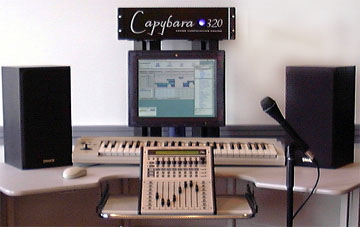
Release Date: 18 January 2000

February 2000 Los Angeles, CA - Symbolic Sound Corporation will be at the Sentech booth W-1805 for the NAMM 2000 show in the West Hall of the downtown LA Convention Center 2-6 February 2000 to demonstrate the close integration of Kyma.5 with Sentech's new Motor Mix™ worksurface.
Every sound synthesis, sampling or processing algorithm in Kyma has parameters that you can adjust in real time. Those parameters appear in a virtual control surface on the computer screen (where you can adjust them using a mouse) and are also mirrored on the Motor Mix worksurface (where you can adjust them by hand).
Presets (or initial settings for the parameters saved in the software) cause the motorized faders on the Motor Mix to jump to their initial positions. Not only that, but parameter labels that appear above the widgets on the virtual control surface are also displayed on the LCD label strip above the real faders on the Motor Mix. Whenever you move a Motor Mix fader, the virtual fader also updates on the computer screen (and vice versa). When you change a virtual fader to a virtual rotary pot on the computer screen, the parameter is automatically remapped to one of the continous rotary pots on the Motor Mix.
"Having software-reconfigurable labels and motorized fader positions gives you virtually unlimited numbers of MIDI faders," according to Symbolic Sound's Carla Scaletti. "Kyma gives you so many real time parameters to tweak that labelling the MIDI faders has always posed a problem. We had customers printing labels on strips and attaching them with velcro so they could switch between them. Now Kyma relabels your faders for you instantaneously and lets you switch between unlimited banks of physical faders. It lets you stay engrossed in the sound instead of trying to remember whether continuous controller 13 was controlling frequency or the compression ratio on the third audio input channel".
Winner of an Electronic Musician magazine Editors' Choice Award for 1998 and featured in the March 1998 Wall Street Journal Entertainment Technology insert, Kyma is a modular, software-based audio synthesis and processing environment accelerated by DSP hardware. Sound designers use a graphical signal flow editor on the screen of either a Macintosh or PC to specify how to synthesize and process the sound. The signal flow diagram is turned into a program for the multiple-DSP Capybara hardware (which connects to the host computer via PCI, NuBus, ISA, or, for laptops, a PC card).
New features of Kyma.5 include a timeline for sequencing and layering of sound algorithms (with sophisticated continuous controller automation), a hot sound library where you can try out different combinations of effects and processing, and a host of new synthesis, processing, and sampling algorithms for sound design and music.
Kyma provides modules for granular synthesis, sample granulation, analog-style synthesis and sequencing, cross-synthesis, alternate tunings, true spectral morphing (not to be confused with crossfading), highly intelligible vocoding, live spectral analysis & resynthesis, cross-synthesis, additive synthesis (synthetic spectra or spectra from analysis), Shepard's tones (the endlessly rising glissando illusion), and more. (For additional information see www.symbolicsound.com).
The Capybara-320 Sound Computation Engine is a multi-processor hardware accelerator for the Kyma software sound design environment. The Capybara 320 provides a minimum of four DSPs (expandable to 28) with multi-channel I/O, synchronization to external clocks, and 96 MB of sample RAM (expandable to 672 Mb) in a low-noise, rack-mountable package connected to a desktop or laptop Macintosh or Windows PC.
Sound designers for music, games, film, and advertising have been using the Kyma software environment (started in 1986 and commercially available since 1991) to design unique sound synthesis and processing algorithms that they can then fine-tune or perform in real time using the Capybara hardware accelerator (without having to rely upon the memory or processing resources of the host computer for sound generation.)
Kyma is being used for sound design in film, advertising, live and recorded music. Listen for Kyma in these recent projects:
and many others. (For up-to-the minute Kyma user news, visit the Eighth Nerve online newsletter.)
The Symbolic Sound Corporation designs, produces, and markets hardware and software for digital audio. The first Kyma system was delivered in January 1991, and has undergone continuous evolution since that time (seven major software upgrades, three hardware upgrades and ports from the original 680xx Macintosh platform to Windows machines, PowerMacs and to laptop PCs and Macintoshes).
For additional information: Symbolic Sound Corporation / P.O. Box 2530 / Champaign IL 61825-2530 / USA
Voice: +1-217-355-6273 Fax: +1-217-355-6562 Toll free in the US: 1-800-972-1749
Email: info-kyma@symbolicSound.com URL: http://www.SymbolicSound.com